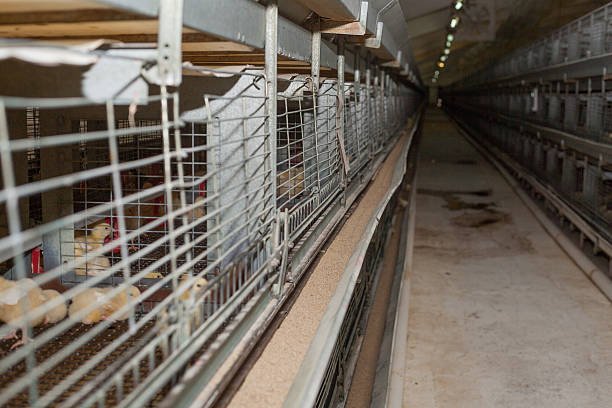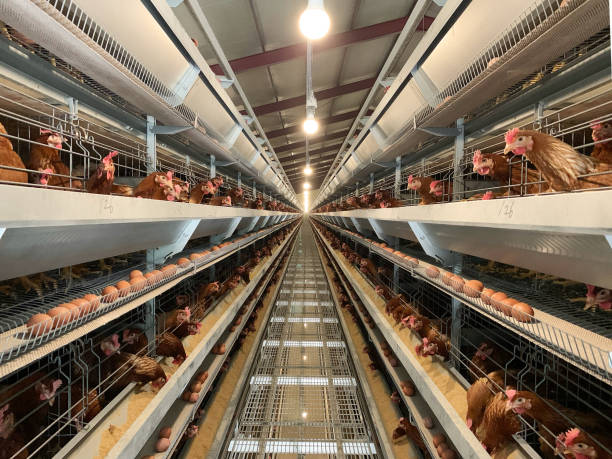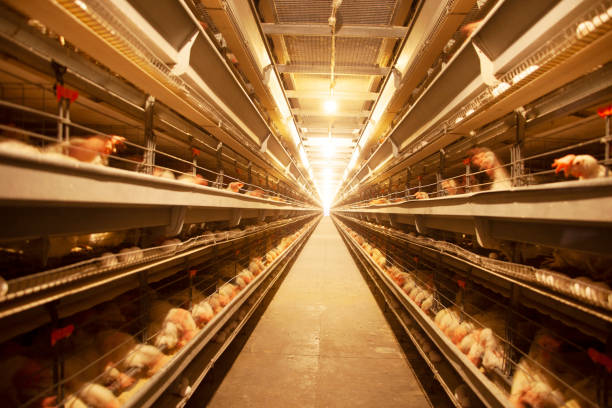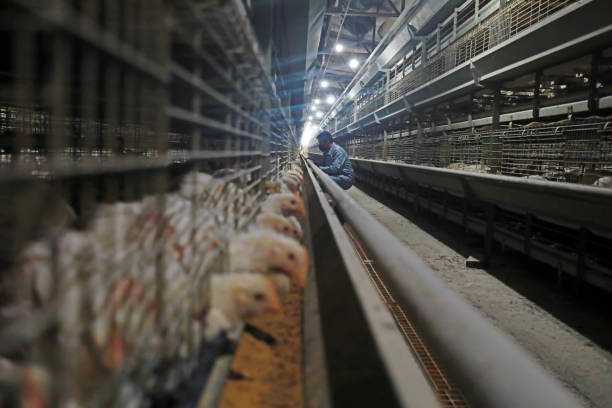Automatic Layer Cages for Sale in India: Price, Quality, and Benefits
Automatic Layer Cages for Sale in India: Price, Quality, and Benefits
India’s poultry industry is booming, driven by rising egg consumption and increasing awareness of efficient farming practices. For layer farmers aiming to maximize egg production while minimizing operational costs, automatic layer cages are becoming an increasingly popular solution. This article delves into the world of automatic layer cages in India, covering aspects like pricing, quality considerations, benefits, and what you need to consider before making a purchase.
Understanding Automatic Layer Cages
Automatic layer cages, also known as battery cages or layer cage systems, are designed to house laying hens in a structured and controlled environment. Unlike traditional free-range or deep litter systems, layer cages offer a higher density of birds per square meter, leading to increased egg production and more efficient resource utilization. The “automatic” aspect refers to the automated features integrated into the system, further streamlining farm operations.
Types of Automatic Layer Cages
There are generally two primary types of automatic layer cages:
A-Type Layer Cages: These cages are arranged in an A-shape, typically stacked in multiple tiers. They are cost-effective and offer good ventilation, making them suitable for smaller to medium-sized farms.
H-Type Layer Cages: Arranged in a horizontal or ladder shape and often used in larger, fully automated poultry farms. They maximize space utilization with several tiers, and allow for advanced automation of feeding, watering, manure removal, and egg collection.
Benefits of Using Automatic Layer Cages

Investing in automatic layer cages can bring a wealth of benefits to poultry farmers:
Increased Egg Production: Layer cages enhance hygiene and protect hens from predators, as temperature can be regulated, and also decrease the spread of diseases, leading to higher survival rates and thus increasing egg production. Cage systems make monitoring individual hen performance for targeted interventions and breeding programs effortless.
Improved Feed Efficiency: Automatic feeding systems deliver precise amounts of feed to each cage, minimizing waste and ensuring that hens receive adequate nutrition. Feed wastage is significantly reduced and hence feed efficiency is better managed.
Reduced Labor Costs: Automation streamlines many routine tasks, such as feeding, watering, egg collection, and manure removal, leading to reduced labor requirements. This frees up farmers to focus on other critical aspects of farm management.
Better Hygiene and Disease Control: Cages raise hens off the ground, minimizing contact with manure and reducing the risk of disease outbreaks. Automated manure removal systems further contribute to a cleaner and healthier environment.
Optimized Space Utilization: Layer cages allow for higher bird density compared to traditional systems, making the most of available space and increasing overall farm productivity.
Easy Management: The cage system allows easy monitoring of the health of the birds, to prevent the spread of disease. The process of vaccination and treatment becomes easier, leading to better flock management.
Factors Affecting the Price of Automatic Layer Cages in India
The price of automatic layer cages in India varies depending on several factors:
Cage Type: H-Type cages are usually more expensive than A-Type cages due to their more complex design and advanced automation features.
Cage Capacity: The number of birds that a cage system can house directly impacts the price. Larger capacity systems will generally cost more.
Automation Level: The degree of automation, including automated feeding, drinking, egg collection, and manure removal, affects the price. More advanced automation leads to higher costs.
Materials Used: The quality of materials used in construction, such as galvanized steel or stainless steel, impacts the durability and price of the cages.
Manufacturer Reputation and Brand: Established manufacturers with a reputation for quality and reliability often charge higher prices.
Installation Costs: Installation costs vary depending on the complexity of the system and the location of the farm.

Import Duties and Taxes: If the cages are imported, import duties and taxes will add to the overall cost.
Estimating the Cost of Automatic Layer Cages
Providing an exact price range for automatic layer cages in India is difficult due to the variability of the factors mentioned above. However, we can provide a general estimate:

A-Type Layer Cages: Prices typically range from ₹300 to ₹600 per bird.
H-Type Layer Cages: Prices generally start from ₹600 and can go upwards of ₹1000 or more per bird, depending on the level of automation.
Important Considerations:
These are just estimates. It is best to get quotations from multiple suppliers to get accurate pricing according to your specific needs.
Remember to factor in additional costs such as transportation, installation, and any necessary building modifications.
Key Quality Considerations
Investing in high-quality automatic layer cages is crucial for long-term profitability and the health of your flock. Here are some essential quality considerations:
Material Quality: Look for cages constructed from high-quality galvanized steel or stainless steel. These materials are durable, corrosion-resistant, and easy to clean.
Cage Design: The cage design should provide adequate space and ventilation for the hens. Ensure that the cages have comfortable flooring to prevent foot injuries.
Automation Components: The quality of the automated components, such as feeding systems, drinking systems, and egg collection systems, is crucial for reliable operation. Look for reputable brands with proven performance.
Welding and Construction: Check the quality of welding and construction to ensure that the cages are strong and stable.
Compliance with Standards: Ensure that the cages comply with relevant safety and animal welfare standards.
Manufacturer Reputation: Buy from reputable manufacturers with a track record of producing high-quality layer cages.
Choosing the Right Supplier
Selecting the right supplier is a critical decision. Here are some factors to consider:
Experience and Reputation: Choose a supplier with a proven track record and positive customer reviews.
Product Range: Look for a supplier that offers a wide range of automatic layer cages to meet your specific needs.
Customization Options: A good supplier should be able to customize the cage system to fit your farm’s layout and requirements.
Installation and Training: Ensure that the supplier provides professional installation services and adequate training on how to operate and maintain the cages.
After-Sales Support: Choose a supplier that offers reliable after-sales support, including spare parts and technical assistance.
Warranty: Check the warranty offered on the cages and automation components.
Local Presence: Opt for a supplier with a local presence in India for faster service and support.
Installation and Maintenance Tips
Proper installation and regular maintenance are essential for maximizing the lifespan and performance of your automatic layer cages. Here are some tips:
Professional Installation: Hire experienced professionals to install the cages correctly.
Regular Cleaning: Clean the cages regularly to prevent the accumulation of manure and dirt.
Lubrication: Lubricate moving parts of the automated systems regularly to ensure smooth operation.
Inspection: Inspect the cages and automated components regularly for signs of wear and tear.
Prompt Repairs: Repair any damage promptly to prevent further problems.
Follow Manufacturer’s Instructions: Always follow the manufacturer’s instructions for operation and maintenance.
Trends in Automatic Layer Cage Technology
The field of automatic layer cage technology is constantly evolving. Here are some notable trends:
Smart Farming: Integration of sensors and data analytics to monitor hen health, egg production, and environmental conditions in real-time. This data can be used to optimize feeding, ventilation, and other farm management practices.
Improved Animal Welfare: Development of cage designs that provide hens with more space, perches, and other enrichments to improve their well-being.
Energy Efficiency: Focus on developing energy-efficient automated systems to reduce operating costs and environmental impact.
Remote Monitoring and Control: Use of mobile apps and cloud-based platforms to allow farmers to remotely monitor and control their layer cage systems.
The Future of Layer Farming in India
Automatic layer cages are poised to play an increasingly important role in the future of layer farming in India. As the demand for eggs continues to grow, farmers will need to adopt efficient and sustainable farming practices to meet this demand. Automatic layer cages offer a proven solution for increasing egg production, reducing labor costs, and improving hygiene and disease control. By investing in high-quality cages and implementing proper management practices, Indian farmers can unlock the full potential of layer farming and contribute to the growth of the poultry industry.
Conclusion
Investing in automatic layer cages is a significant decision for any poultry farmer in India. By carefully considering the factors outlined in this article, you can make an informed decision and choose a cage system that meets your specific needs and budget. Remember to prioritize quality, reliability, and after-sales support to ensure a successful and profitable layer farming operation. With the right automatic layer cages, you can optimize egg production, improve farm efficiency, and contribute to the growth of India’s poultry industry.





